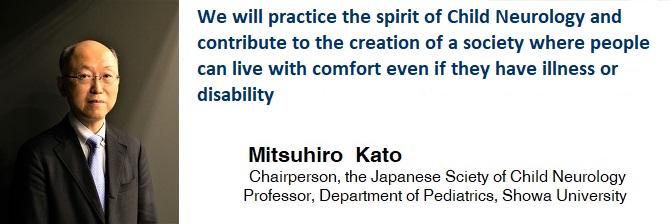Message from the Chairperson

It is a great honor to succeed the past distinguished presidents of the JSCN. The first president was Professor Yukio Fukuyama, who is renowned for the discovery of Fukuyama-type congenital muscular dystrophy and was a founder of the Asian and Oceanian Child Neurology Association. The eighth president, Professor Takao Takahashi, and the ninth president, Professor Akira Oka, served as chairmen of the Japan Pediatric Society as well.
The JSCN originated from the Pediatric Clinical Neurology Study Group (Shoni Rinsho Shinkei-gaku Kenkyu-kai in Japanese) in 1961 and was renamed to JSCN in 1977. The official English journal, “Brain & Development,” was launched in 1979. In 1991, the JSCN established a board certification program and joined the Japanese Association of Medical Sciences, which was the earliest among the pediatric specialties. The number of JSCN members is 3869 (as of May 1st, 2022), and the number of board-certified specialists is 1281, both of which are substantial in the field of child neurology. They are active in all 47 Japanese prefectures, and overseas, and nine local councils are organized nationwide for each region.
The field of pediatric neurology is extensive. Diseases, mainly based on symptoms, include cerebral palsy, motor disorders such as muscular dystrophy, intellectual disability, developmental disorders, paroxysmal disorders such as epilepsy and headache, and sleep disorders. Diseases based on lesions include central nervous system (brain/spinal cord) disorders, peripheral neuropathies, muscle/joint disorders, and skin diseases. Diseases based on pathophysiology include genetic disorders (neurodegenerative disorders, inborn errors of metabolism, congenital anomalies, etc.), neoplastic diseases, infectious or immunological diseases, vascular disorders such as hypoxic-ischemic damage, and those based on extrinsic factors such as trauma, poisoning, and malnutrition. Previously, many neurological disorders in children were enigmas; however, thanks to advancements in neuroimaging and genetic testing, several other disorders have been classified based on their etiology. Almost half of the hereditary diseases are related to child neurology; this means that we target the most diverse diseases as a medical specialty. In addition to medical care, we also commit to social activities in collaboration with welfare and education.
The mission of pediatric neurology is “to protect the brain and nervous systems of children, who have wonderful growth and developmental potential, from harmful risks and minimize the damage inflicted, and achieve harmonious development adequately” as Professor Fukuyama mentioned in the first issue of our official journal, “No to Hattatsu (in Japanese),” in 1969. Medical research and care are rapidly moving forward and are becoming increasingly sophisticated. Currently, gene therapy and regenerative medicine have been realized, and it is becoming possible to recover from, and not just minimize, damage. The JSCN mission cannot be achieved by pediatric neurologists alone. Professor Fukuyama also mentioned, “When studying the development of the brain in children, and its disorders, we shall not be confined to the shell of pediatric neurology in a narrow sense. ‘Multi-disciplinary collaborative study,’ which is closely related to almost all medical sciences, including basic science, maternal and child health, and child psychiatry, as well as the connection with neurology and pediatrics, is extremely important.” Brain science, genetics, molecular biology, and computer sciences, such as deep learning and robot engineering, are progressing remarkably, and clinical medicine and social activities are becoming increasingly complicated. We should now take his advice to heart.
In the history of pediatric neurology in Japan, Ohtahara syndrome or early infantile epileptic encephalopathy with suppression-burst and Segawa disease or dopa-responsive dystonia have been originally described by Professor Shunsuke Otahara and Dr. Masaya Segawa, respectively, based on the characteristic clinical findings as well as Fukuyama-type congenital muscular dystrophy. Causative genes were identified through collaborative research in Japan. They not only reported a disease and identified its cause but are also pioneers in the field of epilepsy, movement disorders, and muscular dystrophy. This has been achieved through “multi-disciplinary collaborative studies.” Collaborative research beyond facilities and countries is common globally. As mentioned above, pediatric neurological disorders are closely subdivided by etiology, many of which are extremely rare and intractable as yet. I deeply support the basic idea of “protecting the most vulnerable person thoroughly,” thoughtfully put forward by the Nationwide Association for Children (Persons) with Severe Physical and Intellectual Disabilities, which is closely related to child neurology. As a professional association, we would like to utilize each field of expertise and promote social activities and collaborative research so that patients and their families can live without worry and have hope for the future. We sincerely appreciate your support.
